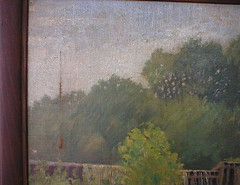
[Mill by a River]. An oil painting (1899). Used courtesy of a private Cleveland area collector.
Ages ago, when I began assembling material for the exhibition I curated for the Cleveland Artists Foundation on the life and work of I.T. Frary, I asked if you, my readers, might have some of his paintings in your collections.
The exhibition, Designing History: I.T. Frary; Interior Design and the Beginnings of Historic Preservation in Ohio traced Frary's career, from his beginnings in art school, through the work that he did as an artist and interior designer, to his landmark book, Early Homes of Ohio, published in 1936, which remains the best general work on historic architecture in this state.

Smith House, Adams Mills, Ohio A watercolor painting (1904). From the collection of Jim Oswald.
A couple great watercolor paintings had remained in the Frary family.

H.A. Smith House, Adams Mills A watercolor painting (1905). From the collection of Jim Oswald.
They depict the landscape in Adams Mills, in Muskingum County, Ohio, where Frary's wife's family lived.

Zoar A watercolor painting (1898). Collection of the Cleveland Artists Foundation..
Another watercolor, the only one in private hands outside the Frary family, depicts a scene in Zoar, Ohio. It is now in the collections of the Cleveland Artists Foundation. Frary made the painting while a student of F.C. Gottwald.
Still, I knew that there had to be more of his paintings out there. Frary had exhibited dozens, at the least - and they were good paintings. They couldn't have all disappeared, could they?

[Mill by a River]. An oil painting (1899). Used courtesy of a private Cleveland area collector.
Then, a few months ago, I received and email from a private collector, who had purchased this oil painting at an estate sale years ago. It's the first oil painting that I've found by Frary - and I can't figure out where the scene is! We know that I.T. Frary painted in the vicinity of Zoar, Chagrin Falls, and Adams Mills, Ohio. Could it be one of these, or possibly something in the vicinity of Cleveland? What do you see?


[Mill by a River]. An oil painting (1899). Used courtesy of a private Cleveland area collector.
Here are a couple details, with the hope that they may help in the identification of the piece.




An interesting problem.
ReplyDeleteThe painting provides enough information to suggest an Ohio scene, but not likely in Northeast Ohio. More likely, the scene lies south of the Great Lakes-Mississippi divide, west of the Appalachian foothills, yet east of Columbus. Using the following evidence I suggest a site in the upper reaches of either the Tuscarawas or Scioto watersheds.
Sandstone knick point mill site.
The mill seems situated in relation to a waterfall on a rock outcrop. The mill race is constructed of large stone blocks, which were probably quarried from the outcrop. This would be a classic “knick point” mill site, set up where a stream falls over a resistant bedrock unit. In such conditions the knick point face migrates upstream as the stream erodes blocks from the outcrop. A few such blocks appear to lie downstream of the knick point. In that the millrace stones, detached blocks, and the streambed are buff colored, instead of gray, they would seem to be sandstone, not limestone.
In Ohio, sandstone country lies generally east of the Columbus area. Limestone country lies west. Our sandstone country has two massive units upon which knick point mills were built. The Sharon sandstone is the higher one and it underlies the high area along the Great Lakes-Mississippi divide, Some 200’ below, the Berea Sandstone forms a lower unit. From the Great Lakes-Mississippi divide, streams flow northward and southward to fall over both rock units. I suspect that the mill scene lies at a knick point on one of these units.
South of the Great Lakes-Mississippi divide.
North of the divide, the Lake Erie tributaries cut through the two units as they descend the Allegheny Escarpment. This makes for short, steep streams entrenched in narrow valleys. Banks rise steeply from streambeds. South of the divide the descent to the Ohio River is much longer and much less steep. Ohio River tributaries are broader and banks rise less steeply. The exceptions are the Appalachia east-flowing Ohio tributaries which are also entrenched.
The painting shows a stream of the Ohio River tributary type, say in the upper Tuscarawas or Scioto watersheds.